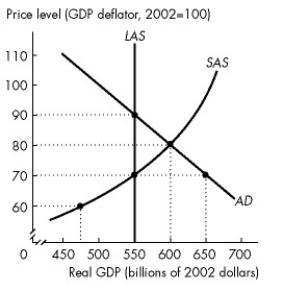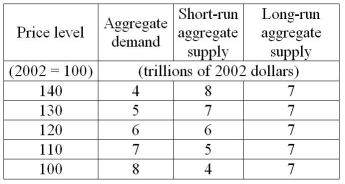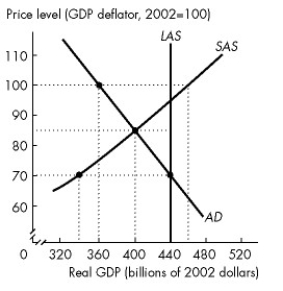A) an increase in the price level will not expand an economy's output in the long run.
B) output rates greater than the long-run output rate are unattainable.
C) an increase in the price level will permit the economy to achieve a higher level of output.
D) an increase in the price level will increase technological change and economic growth.
E) the long-run aggregate supply curve never shifts.
Correct Answer

verified
Correct Answer
verified
Multiple Choice
The world goes into an expansion. This event
A) decreases Canada's aggregate demand and decreases Canada's short-run aggregate supply.
B) increases Canada's short-run aggregate supply.
C) decreases Canada's aggregate demand.
D) increases Canada's aggregate demand.
E) increases Canada's long-run aggregate supply.
Correct Answer

verified
Correct Answer
verified
Multiple Choice
Use the figure below to answer the following questions.
 Figure 26.3.2
-Refer to Figure 26.3.2. Consider statements (1) and (2) and select the correct answer. (1) The economy of Mythlo is experiencing an above full-employment equilibrium.
(2) SAS will automatically shift rightward as the economy adjusts to long-run equilibrium.
Figure 26.3.2
-Refer to Figure 26.3.2. Consider statements (1) and (2) and select the correct answer. (1) The economy of Mythlo is experiencing an above full-employment equilibrium.
(2) SAS will automatically shift rightward as the economy adjusts to long-run equilibrium.
A) (1) is true; (2) is false.
B) (2) is true; (1) is false.
C) (1) and (2) are false.
D) (1) and (2) are true.
E) (1) is true; (2) is true only if the LAS curve shifts rightward at the same time.
Correct Answer

verified
Correct Answer
verified
Multiple Choice
The defining feature of the classical view of macroeconomics is that the economy is
A) rarely at full employment.
B) driven by expectations called "animal spirits."
C) self-regulating and always at full employment.
D) constantly bombarded by shocks that arise from the uneven pace of technological change.
E) the most significant influence on aggregate demand is expectations.
Correct Answer

verified
Correct Answer
verified
Multiple Choice
Which one of the following variables is not held constant along a given aggregate demand curve?
A) fiscal policy
B) monetary policy
C) the exchange rate
D) expectations about inflation
E) the price level
Correct Answer

verified
Correct Answer
verified
Multiple Choice
Use the table below to answer the following questions.
Table 26.3.3
 -Refer to Table 26.3.3. With no interference from the central bank or the government, the
-Refer to Table 26.3.3. With no interference from the central bank or the government, the
A) short-run aggregate supply curve will shift rightward.
B) short-run aggregate supply curve will shift leftward.
C) long-run aggregate supply curve will shift rightward.
D) long-run aggregate supply curve will shift leftward.
E) Both A and C will occur.
Correct Answer

verified
Correct Answer
verified
Multiple Choice
Use the table below to answer the following questions.
Table 26.3.1
 -Refer to Table 26.3.1. Consider the economy represented in the table. The economy eventually moves to its long-run equilibrium. In long-run equilibrium, the price level is ________ and real GDP is ________ billion.
-Refer to Table 26.3.1. Consider the economy represented in the table. The economy eventually moves to its long-run equilibrium. In long-run equilibrium, the price level is ________ and real GDP is ________ billion.
A) 125; $550
B) 120; $600
C) 120; $500
D) 130; $600
E) 130; $500
Correct Answer

verified
Correct Answer
verified
Multiple Choice
Use the figure below to answer the following questions.
 Figure 26.3.1
-Refer to Figure 26.3.1. As Econoworld automatically adjusts to long-run equilibrium, the
Figure 26.3.1
-Refer to Figure 26.3.1. As Econoworld automatically adjusts to long-run equilibrium, the
A) SAS curve shifts rightward.
B) AD curve shifts rightward.
C) SAS curve shifts leftward.
D) AD curve shifts leftward.
E) LAS curve shifts leftward.
Correct Answer

verified
Correct Answer
verified
Multiple Choice
An increase in oil prices to a country that is a net importer of oil shifts
A) both the short-run aggregate supply and long-run aggregate supply curves rightward.
B) both the short-run aggregate supply and long-run aggregate supply curves leftward.
C) the short-run aggregate supply curve leftward, but leaves the long-run aggregate supply curve unchanged.
D) the long-run aggregate supply curve rightward, but leaves the short-run aggregate supply curve unchanged.
E) the short-run aggregate supply curve leftward, but shifts the long-run aggregate supply curve rightward.
Correct Answer

verified
Correct Answer
verified
Multiple Choice
When an economy is operating on its long-run aggregate supply curve,
A) the actual inflation rate is greater than the anticipated inflation rate.
B) the actual unemployment rate equals the natural unemployment rate.
C) unemployment will fall to an unusually low rate that is not likely to last into the future.
D) real GDP demanded exceeds real GDP supplied.
E) inflation must be positive.
Correct Answer

verified
Correct Answer
verified
Multiple Choice
If real GDP is less than potential GDP, then the economy is
A) not in short-run equilibrium.
B) in a full-employment equilibrium.
C) in an above full-employment equilibrium.
D) in a below full-employment equilibrium.
E) in long-run equilibrium.
Correct Answer

verified
Correct Answer
verified
Multiple Choice
If the price level rises, then the wealth effect leads to
A) an increase in real wealth, an increase in current consumption expenditure, and an increase in saving.
B) an increase in real wealth, an increase in current consumption expenditure, and a decrease in saving.
C) a decrease in real wealth, an increase in current consumption expenditure, and an increase in saving.
D) a decrease in real wealth, an increase in current consumption expenditure, and a decrease in saving.
E) a decrease in real wealth, a decrease in current consumption expenditure, and an increase in saving.
Correct Answer

verified
Correct Answer
verified
Multiple Choice
Which of the following statements about the monetarist view of the macroeconomy is incorrect?
A) The money wage rate is sticky.
B) Taxes should be kept low to avoid disincentive effects that decrease potential GDP.
C) All recessions result from inappropriate monetary policy.
D) Left alone, the economy rarely operates at full employment.
E) Provided that the quantity of money is kept on a steady growth path, no active stabilization is needed to offset changes in aggregate demand.
Correct Answer

verified
Correct Answer
verified
Multiple Choice
If a change in wealth is induced by a change in the price level, then this would be shown as a
A) movement along the aggregate demand curve.
B) shift of the aggregate demand curve due to the substitution effects.
C) movement along the aggregate demand curve due to the substitution effects.
D) movement along the aggregate supply curve.
E) shift of the aggregate demand curve due to the wealth effect.
Correct Answer

verified
Correct Answer
verified
Multiple Choice
Which one of the following is a reason for the negative slope of the aggregate demand curve?
A) the real wage effect
B) the substitution effect
C) the expected inflation effect
D) the nominal balance effect
E) the income effect
Correct Answer

verified
Correct Answer
verified
Multiple Choice
Everything else remaining the same, an increase in foreign income
A) increases Canada's aggregate supply.
B) increases Canada's aggregate demand.
C) decreases Canada's aggregate demand.
D) creates a movement downward along Canada's aggregate demand curve.
E) decreases Canada's aggregate supply.
Correct Answer

verified
Correct Answer
verified
Multiple Choice
Use the table below to answer the following questions.
Table 26.3.1
 -Refer to Table 26.3.1. Consider the economy represented in the table. The economy is in
-Refer to Table 26.3.1. Consider the economy represented in the table. The economy is in
A) a long-run equilibrium, and resource prices will not change.
B) an above full-employment equilibrium, and factor prices will increase.
C) an above full-employment equilibrium, and factor prices will decrease.
D) a below full-employment equilibrium, and factor prices will decrease.
E) a below full-employment equilibrium, and factor prices will increase.
Correct Answer

verified
Correct Answer
verified
Multiple Choice
An inflationary gap is the amount by which
A) potential GDP exceeds real GDP.
B) demand must increase to achieve full employment at a given price level.
C) supply must increase to achieve full employment at a given price level.
D) the price level must adjust to achieve full employment.
E) real GDP exceeds potential GDP.
Correct Answer

verified
Correct Answer
verified
Multiple Choice
Use the figure below to answer the following questions.
 Figure 26.3.1
-Refer to Figure 26.3.1. Short-run macroeconomic equilibrium real GDP in Econoworld is
Figure 26.3.1
-Refer to Figure 26.3.1. Short-run macroeconomic equilibrium real GDP in Econoworld is
A) $360 billion.
B) $400 billion.
C) $440 billion.
D) $480 billion.
E) $520 billion.
Correct Answer

verified
Correct Answer
verified
Multiple Choice
The defining feature of the Keynesian view of macroeconomics is
A) that the economy is rarely at full employment.
B) that the economy is self-regulating and always at full employment.
C) that the quantity of money is the most significant influence on aggregate demand.
D) that the economy is constantly bombarded by shocks that arise from the uneven pace of technological change.
E) that no active stabilization is needed to offset changes in aggregate demand.
Correct Answer

verified
Correct Answer
verified
Showing 81 - 100 of 136
Related Exams